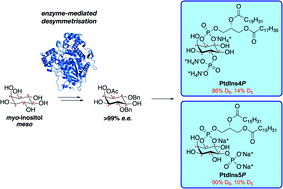Development of isotope-enriched phosphatidylinositol-4- and 5-phosphate cellular mass spectrometry probes†
Abstract
Synthetic phosphatidylinositol phosphate (PtdInsPn) derivatives play a pivotal role in broadening our understanding of PtdInsPn metabolism. However, the development of such tools is reliant on efficient enantioselective and regioselective synthetic strategies. Here we report the development of a divergent synthetic route applicable to the synthesis of deuterated PtdIns4P and PtdIns5P derivatives. The synthetic strategy developed involves a key enzymatic desymmetrisation step using Lipozyme TL-IM®. In addition, we optimised the large-scale synthesis of deuterated myo-inositol, allowing for the preparation of a series of saturated and unsaturated deuterated PtdIns4P and PtdIns5P derivatives. Experiments in MCF7 cells demonstrated that these deuterated probes enable quantification of the corresponding endogenous phospholipids in a cellular setting. Overall, these deuterated probes will be powerful tools to help improve our understanding of the role played by PtdInsPn in physiology and disease.



 Please wait while we load your content...
Please wait while we load your content...